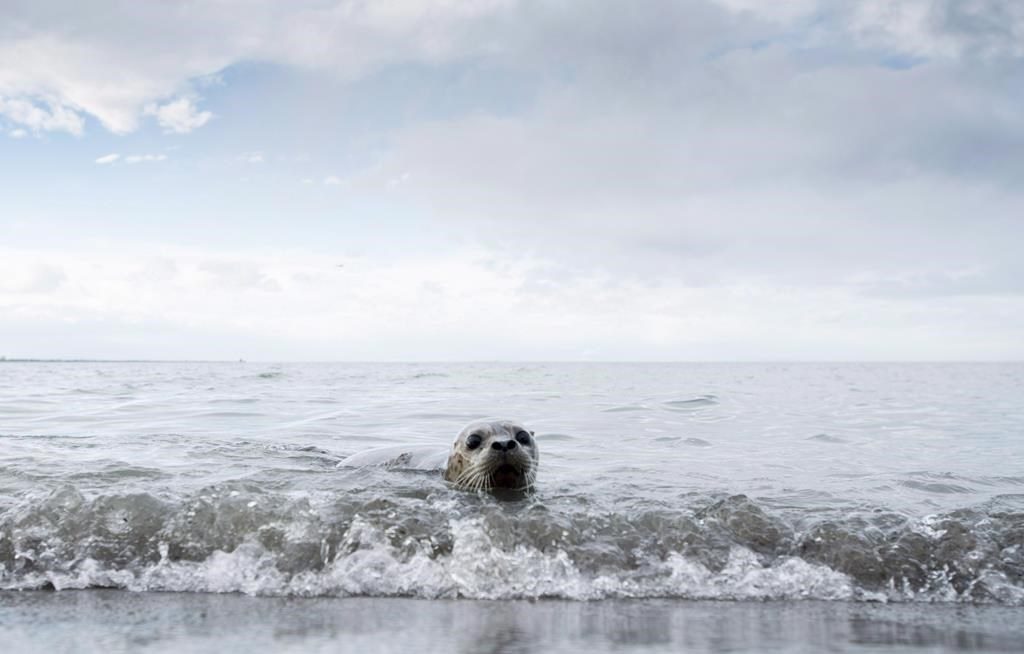Avian Flu: An investigation reveals the deaths of infected seals in Quebec

Posted November 24, 2024 4:41 pm.
Last Updated November 24, 2024 4:45 pm.
The infection of mammal species by avian flu viruses is raising concerns. The replication of cells in mammals could make the virus more pathogenic to humans. A recent investigation into the increase in seal deaths in the St. Lawrence River in 2022 sheds light on this risk.
Between April 1 and September 30, 2022, 209 dead or sick seals were reported in the estuary and Gulf of the St. Lawrence. The rise in summer deaths among common and gray seals was nearly four times greater than historical data. In several cases, the H5N1 strain of avian flu was identified as the cause of death.
The results of an investigation published by the Centers for Disease Control and Prevention (CDC) suggest that the presence of a large number of bird carcasses infected with H5N1 at seal haul-out sites likely contributed to the spread of the infection to pinnipeds.
Current data do not allow for determining if seal-to-seal transmission occurred. “In the outbreak we saw in 2022, especially among common seals, there seems to be no evidence that the virus was transmitted from one seal to another. What we can think is that the disease was so acute, the death so rapid, that the animals didn’t have time to excrete the virus for long,” explained Stéphane Lair, co-author of the investigation.
That being said, the current H5N1 strain has caused “very significant” deaths among pinnipeds, especially sea lions in South America. “We are talking about several thousand animals that died, which suggests that in these cases, there was transmission from one sea lion to another. And in these sea lion colonies, they have much closer contact with each other, which could have facilitated direct transmission between the animals,” Lair noted.
His research highlights that marine mammals could serve as reservoirs for the H5N1 avian flu virus, potentially increasing the risk of mutations that could enable the infection of new mammalian hosts. Therefore, monitoring this virus in wild marine mammal populations is essential for assessing the public health risk associated with this emerging pathogen-host dynamic, as stated in the CDC report.
More recently in Quebec, the Canadian Food Inspection Agency conducted two investigations related to avian influenza in domestic birds. The infection was detected on November 17 and 18 at two poultry farms in Montérégie.
No Panic, According to Two Experts
The first case of H5N1 avian flu in a human in Canada was confirmed last week in British Columbia.
According to two experts, there is no need to panic about the possibility of the virus spreading to humans, as cases are few.
“There have already been some reported human cases. These are quite limited in number, which suggests that this virus is not very well adapted to humans,” said Lair, who is also a professor at the Faculty of Veterinary Medicine at the University of Montreal.
“What we need to understand about influenza viruses is that they recombine with other viruses, they mutate. So, they can change over time. The strain circulating in North America right now is an Eurasian strain, which is different from the Asian strain that caused several human cases. This strain seems much less able to spread among humans than the Asian strain,” he explained.
What is more concerning, according to Lair, is that this virus can mutate, and we do not know what adaptations future generations of the virus may have.
“Public health is always a little more concerned when this avian virus starts infecting mammals like seals because it shows that it is adapting to mammalian cells, and since we are mammals, we can ask ourselves: Are we next on the list?” he said.
Brian Ward, professor at the Department of Medicine at McGill University and co-director of the Vaccine Study Centre at the MUHC, also has moderate concerns. “It’s worrying, but it’s worrying at a low level,” he said.
“In recent years, there have been cases in sea lions, farm animals, and domestic birds. But in wild birds, especially seabirds and geese and ducks, these viruses have been circulating very actively for decades. We now have historical records of multiple clades, and yes, there are mutations that make transmission to mammals easier,” he explained.
So far, there have been no cases of human-to-human transmission. “There is no huge signal that this will change rapidly,” Ward commented.
“Transmission in birds is mostly through the oral-fecal route, so feces contain the virus. There are birds around the seals. Aerosols are formed in these environments. It’s possible that even without the proper receptor for infection, the seal could get sick due to the intensity of the aerosols,” Ward noted.
Both Lair and Ward agree that the next pandemic could be an avian flu virus. However, they believe there is no need to panic just yet.
“No need to panic at the moment, but we should use this moment, now that these viruses have our attention. We need to use this motivation to be better prepared when one of these viruses comes out, or another virus like SARS-CoV-2. We must prepare for the next pandemics because they are inevitable,” Ward argued.
–This report by La Presse Canadienne was translated by CityNews








